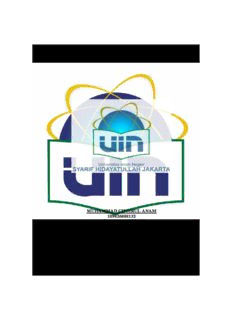
an analysis of request strategies in andrea hirata's novel rainbow troops PDF
Preview an analysis of request strategies in andrea hirata's novel rainbow troops
AN ANALYSIS OF REQUEST STRATEGIES IN ANDREA HIRATA’S NOVEL RAINBOW TROOPS MUHAMMAD CHOIRUL ANAM 109026000132 ENGLISH LETTERS DEPARTMENT LETTERS AND HUMANITIES FACULTY STATE ISLAMIC UNIVERISTY “SYARIF HIDAYATULLAH” JAKARTA 2016 ABSTRACT Muhammad Choirul Anam, Request Strategy on Andrea Hirata’s Novel Rainbow Troops. Thesis: English Letters Department, Adab and Humanities Faculty, Syarif Hidayatullah Jakarta State Islamic University, 2016. The research of Request, in any forms, has progressively increased in the great number. However, the cross-cultural comparison of request strategy has attracted considerable interest. This research is Request Strategies framework and uses a Andrea Hiarata‟s Novel Rainbow Troops as the corpus. The focus of this research is to insvestigate the realisation of Request Strategy used by character in the novel and the aim of each strategy by using Hyme‟s theory of SPEAKING. Based on the research findings, the writer finds that the frequency of direct request to occur in Andrea Hirata„s novel extremely frequent more than conventionally indirect request. and nonconventianally indirect request. Based on Hymes„ theory of SPEAKING, expressions showing request strategies, is not merely to show the real request. Based in the data in this study, there are six different aims inferred from the context to show how direct request and conventionally indirect request are used. Although, among six aims, to express the real request is still the most dominant one. This research is descriptive qualitative method. Key words: Request, Request Strategies, Hyme’s theory of SPEAKING i APPROVEMENT ii LEGALIZATION iii DECLARATION I hereby declare that this submission is my own work and that, to the best of my knowledge and belief, it contains no material previously published or written by another person nor material which to a subtantial extent has been accepted for the award or any other degree or diploma of the university or institute of higher learning, except where due acknowledgement has been made in text. Jakarta, November 28, 2016 Muhammad Choirul Anam iv 4. Dr. Frans Sayogie, S.H., M.H., M.Pd. for his kindness, suggestion, patience in guiding the writer to complete the thesis. 5. All the lecturers of the English Letters Department, for their worthy and valuable dedication to teach in full of patience and sincerity as long as his study. 5. Ka Jesika, the Assistant Secretaray of English Letters Department. 6. All D Classmate of English Letters Department 2009, notably to Rohmatullah Umar, Gorbi Zumroni, Ahmad Syauqi, Syaiful Bahri, Saughie, who always inspire and support him. 7. Student Executive Board of English Letters and Ex President Bang Bed, Bang Iir, and Ex Ketum Deden. Thank you to unite us in “The Everlasting Brotherhood”. Also to all friends 2009 English Letters. 8. All friends of HMI, a place where all the sacred things are questioned. Thanks for the brotherhood in intellectual emotional 9. The last Big thanks to big family of Ikatan Mahasiswa Lebak (IMALA), Dudi Haryudi, Asep Kutep, Chandra, Wadde, Dedin, Iyus, Dina, Meysa, Dina, Aang Ahong, Yudi and to all Alumni, Bang Ajuba, Kang Rangga, Kang Ajat, Kang Suhro, Kang Acep, and all who can not be mentioned. Jakarta, June 2016 Muhammad Choirul Anam vi TABLE OF CONTENTS ABSTRACT ............................................................................................................ i APPROVEMENT ................................................................................................. ii DECLARATION ................................................................................................... ii ACKNOWLEDGMENT ....................................................................................... v TABLE OF CONTENTS ..................................................................................... vi CHAPTER I. INTRODUCTION A. Background of the Research ................................................. 1 B. Focus of the Research ........................................................... 4 C. Research Question ................................................................ 4 D. Objective of the Research ..................................................... 4 E. Significance of the Research ................................................ 5 F. Research Methodology ......................................................... 5 1. Method of Research ........................................... 5 2. Technique of Data Collectig and Analysis........ 5 3. Unit Analysis ...................................................... 6 4. Instrument .......................................................... 6 CHAPTER II. THEORETICAL FRAMEWORK A. Previous Research ................................................................. 6 B. Theory ................................................................................. 10 vii 1. Request .................................................................. 10 2. Request Strategies................................................. 12 a. Direct Strategies ................................................. 16 b. Conventionally Indirect Strategies ..................... 17 c. Nonconventionally Indirect Strategies ............... 18 3 Hyme‟s Ethnography of SPEAKING ...................... 19 C. Synopsis .............................................................................. 23 CHAPTER III. RESEARCH FINDINGS A. Data Description ................................................................. 24 B. Data Analysis ...................................................................... 36 CHAPTER IV. CONCLUSION AND SUGGESTION A. Conclusion .......................................................................... 44 B. Suggestion .......................................................................... 45 BIBLIOGRAPHY ............................................................................................... 46 APPENDIX ........................................................................................................... 48 viii CHAPTER I INTRODUCTION A. Background of the Research Language is a system that allows people to communicate or transfer their proportion among themselves.1 It is the way to express things both individually or socially. In social interaction, people use language to acompolish various things or actions which involve other people, such as request, compliment, critic, and so on. Cited in Holtgraves, Clark assumes people must be connected with other in order to understand and to be understood.2 Consequently, linguistic action affects how the interractants think and feel each other. To make successful a communication, the interractants should entail not only the knowledge of grammar and text organization but also the pragmatic aspects of target language.3 Indeed, the interractants should ideally be able to use language in effective and efficient manner as described in pragmatic. Pragmatics reveals how to understand the meaning of produced utterance by the speaker during communication. Futhermore, pragmatics relates to study of meaning of communicated utterance by speaker and interpetation of a listener. Consequently, it has more to do with the analysis of what people intend by their utterances than what kind of words or phrases in those utterances might they 1 Thomas Holtgraves. 2002. Language As Social Action : Social Psychology and Language Use. (London: Publishers Mahwah) p. 1 2 Ibid. 3 Imen Aribi. 2011. A Socio-Pragmatic Study of the Use of Request in English by Tunisian EFL Learners. (Journal of Second Language Teaching and Research. Volume 2 Issue 1) p. 87 1
Description: